Related Research Articles
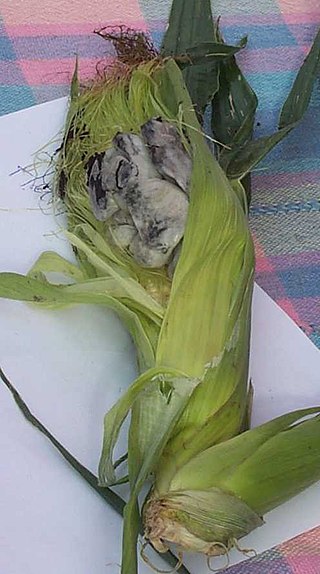
Ustilaginomycetes is the class of true smut fungi. They are plant parasites with about 1400 recognised species in 70 genera. They have a simple septum with a septal pore cap, this is different from Agaricomycotina which has a dolipore septum with parenthoesome. The group is monophyletic.

Osmundastrum is genus of leptosporangiate ferns in the family Osmundaceae with one living species, Osmundastrum cinnamomeum, the cinnamon fern. It is native to the Americas and eastern Asia, growing in swamps, bogs and moist woodlands.

The Ustilaginales are an order of fungi within the class Ustilaginomycetes. The order contained 8 families, 49 genera, and 851 species in 2008.
Thecaphora is a genus of basidiomycote fungus which contains several species of plant pathogens. The widespread genus contained about 57 species in 2008. and held 61 species in 2020.
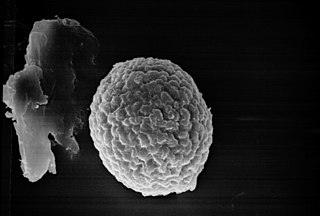
Tilletia is a genus of smut fungi in the Tilletiaceae family. Species in this genus are plant pathogens that affect various grasses. Tilletia indica, which causes Karnal bunt of wheat, and Tilletia horrida, responsible for rice kernel smut, are examples of species that affect economically important crops.

The Tilletiales are an order of smut fungi in the class Exobasidiomycetes. It is a monotypic order, consisting of a single family, the Tilletiaceae, which contains seven genera. The roughly 150 species in the Tilletiales all infect hosts of the grass family, except for species of Erratomyces, which occur on legumes.
Conidiosporomyces is a genus of fungi in the smut family Tilletiaceae. The genus was described in 1992 to accommodate the species formerly known as Tilletia ayresii, first described by British naturalist Miles Joseph Berkeley in 1899. The species C. verruculosus was described in 1993. Species in the genus are plant pathogens that affect various grasses.
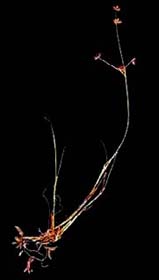
Entorrhizomycetes is the sole class in the phylum Entorrhizomycota within the Fungi subkingdom Dikarya along with Basidiomycota and Ascomycota. It contains three genera and is a small group of teliosporic root parasites that form galls on plants in the Juncaceae (rush) and Cyperaceae (sedge) families. Prior to 2015 this phylum was placed under the subdivision Ustilaginomycotina. A 2015 study did a "comprehensive five-gene analyses" of Entorrhiza and concluded that the former class Entorrhizomycetes is possibly either a close sister group to the rest of Dikarya or Basidiomycota.

The Mixiomycetes are a class of fungi in the Pucciniomycotina subdivision of the Basidiomycota. The class contains a single order, the Mixiales, which in turn contains a single family, the Mixiaceae that circumscribes the monotypic genus Mixia. Only one species has been described to date, Mixia osmundae; this species was originally named Taphrina osmundae by Japanese mycologist Toji Nishida in 1911. It is characterized by having multinucleate hyphae, and by producing multiple spores on sporogenous cells.

The Ustilaginaceae are a family of smut fungi in the order Ustilaginomycetes. Collectively, the family contains 17 genera and 607 species.
The Geminaginaceae are a family of smut fungi in the order Ustilaginomycetes. The family is monotypic, containing the single genus, Geminago, with the single species Geminago nonveilleri. It was originally found on the inflorescence of Triplochiton scleroxylon in Cameroon, Africa. It was published and described as Mycosyrinx nonveilleri by Zambett. & Foko in Revue Mycol., Paris 35(5): 304 in 1971. Before being renamed in 1996 by Vánky & R. Bauer.
The Microbotryales are an order of fungi in the Microbotryomycetes class of the Basidiomycota. The order contains 2 families, 9 genera, and 114 species. The order was circumscribed in 1997.
The Melanotaenium is a genus of smut fungi in the family Melanotaeniaceae.
Yelsemia is a genus of smut fungi in the family Melanotaeniaceae, containing four species.
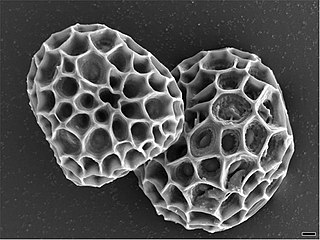
Bauerago is a genus of fungi found in the family Microbotryaceae. It contained 9 species before being reduced to 5 species.
Robert Bauer was a German mycologist, specialising in rust (Uredinales) and smut (Ustilaginomycetes) fungi.
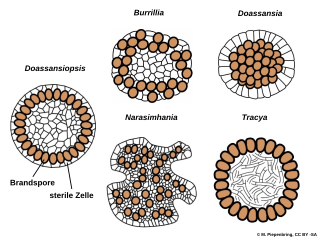
Doassansiopsis is a genus of smut fungi belonging to the monotypic family DoassansiopsidaceaeBegerow, R.Bauer & Oberw., 1998, within the class Ustilaginomycetes and order Urocystidales.

The Urocystidales are an order of fungi within the class Ustilaginomycetes. The order contains 6 families and about 400 genera. They are a sister order to Ustilaginales.

The Doassansiaceae are a family of fungi in the division Basidiomycota and order of Doassansiales. The family contains 11 genera and about 58 species. They have a widespread distribution. Doassansiaceae is also known and classified as a smut fungi.
The Melaniellaceae are a family of fungi in the division Basidiomycota and order of Doassansiales. The family contains 1 genera and 2 species. They have a distribution in south and south-east Asia.